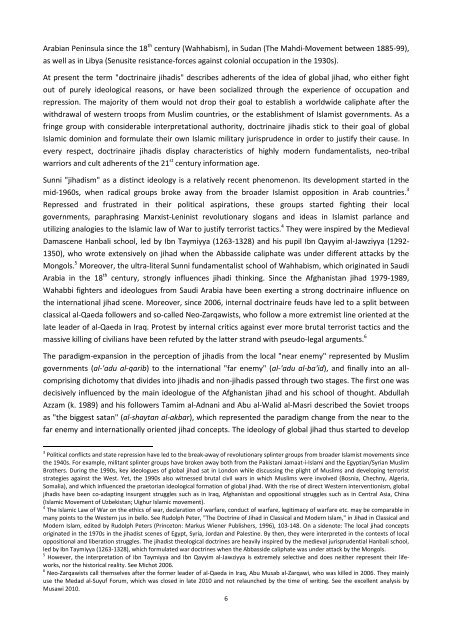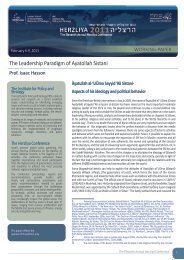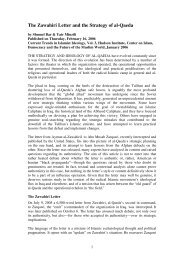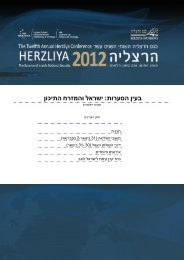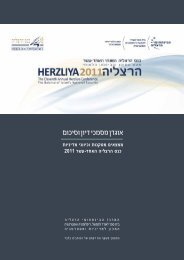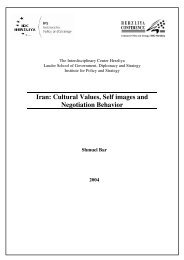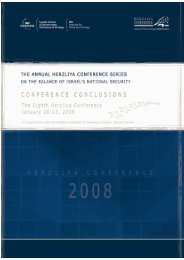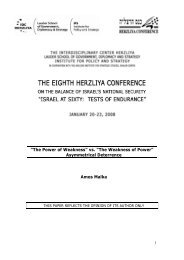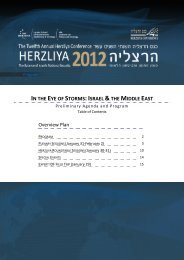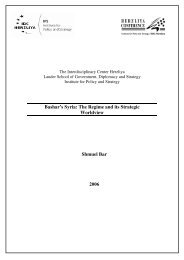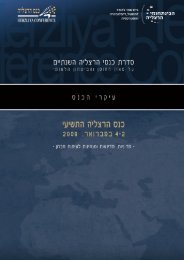Classical Islamic Paradigms of Deterrence and their Expression in ...
Classical Islamic Paradigms of Deterrence and their Expression in ...
Classical Islamic Paradigms of Deterrence and their Expression in ...
You also want an ePaper? Increase the reach of your titles
YUMPU automatically turns print PDFs into web optimized ePapers that Google loves.
Arabian Pen<strong>in</strong>sula s<strong>in</strong>ce the 18 th century (Wahhabism), <strong>in</strong> Sudan (The Mahdi-Movement between 1885-99),as well as <strong>in</strong> Libya (Senusite resistance-forces aga<strong>in</strong>st colonial occupation <strong>in</strong> the 1930s).At present the term "doctr<strong>in</strong>aire jihadis" describes adherents <strong>of</strong> the idea <strong>of</strong> global jihad, who either fightout <strong>of</strong> purely ideological reasons, or have been socialized through the experience <strong>of</strong> occupation <strong>and</strong>repression. The majority <strong>of</strong> them would not drop <strong>their</strong> goal to establish a worldwide caliphate after thewithdrawal <strong>of</strong> western troops from Muslim countries, or the establishment <strong>of</strong> Islamist governments. As afr<strong>in</strong>ge group with considerable <strong>in</strong>terpretational authority, doctr<strong>in</strong>aire jihadis stick to <strong>their</strong> goal <strong>of</strong> global<strong>Islamic</strong> dom<strong>in</strong>ion <strong>and</strong> formulate <strong>their</strong> own <strong>Islamic</strong> military jurisprudence <strong>in</strong> order to justify <strong>their</strong> cause. Inevery respect, doctr<strong>in</strong>aire jihadis display characteristics <strong>of</strong> highly modern fundamentalists, neo-tribalwarriors <strong>and</strong> cult adherents <strong>of</strong> the 21 st century <strong>in</strong>formation age.Sunni "jihadism" as a dist<strong>in</strong>ct ideology is a relatively recent phenomenon. Its development started <strong>in</strong> themid-1960s, when radical groups broke away from the broader Islamist opposition <strong>in</strong> Arab countries. 3Repressed <strong>and</strong> frustrated <strong>in</strong> <strong>their</strong> political aspirations, these groups started fight<strong>in</strong>g <strong>their</strong> localgovernments, paraphras<strong>in</strong>g Marxist-Len<strong>in</strong>ist revolutionary slogans <strong>and</strong> ideas <strong>in</strong> Islamist parlance <strong>and</strong>utiliz<strong>in</strong>g analogies to the <strong>Islamic</strong> law <strong>of</strong> War to justify terrorist tactics. 4 They were <strong>in</strong>spired by the MedievalDamascene Hanbali school, led by Ibn Taymiyya (1263-1328) <strong>and</strong> his pupil Ibn Qayyim al-Jawziyya (1292-1350), who wrote extensively on jihad when the Abbasside caliphate was under different attacks by theMongols. 5 Moreover, the ultra-literal Sunni fundamentalist school <strong>of</strong> Wahhabism, which orig<strong>in</strong>ated <strong>in</strong> SaudiArabia <strong>in</strong> the 18 th century, strongly <strong>in</strong>fluences jihadi th<strong>in</strong>k<strong>in</strong>g. S<strong>in</strong>ce the Afghanistan jihad 1979-1989,Wahabbi fighters <strong>and</strong> ideologues from Saudi Arabia have been exert<strong>in</strong>g a strong doctr<strong>in</strong>aire <strong>in</strong>fluence onthe <strong>in</strong>ternational jihad scene. Moreover, s<strong>in</strong>ce 2006, <strong>in</strong>ternal doctr<strong>in</strong>aire feuds have led to a split betweenclassical al-Qaeda followers <strong>and</strong> so-called Neo-Zarqawists, who follow a more extremist l<strong>in</strong>e oriented at thelate leader <strong>of</strong> al-Qaeda <strong>in</strong> Iraq. Protest by <strong>in</strong>ternal critics aga<strong>in</strong>st ever more brutal terrorist tactics <strong>and</strong> themassive kill<strong>in</strong>g <strong>of</strong> civilians have been refuted by the latter str<strong>and</strong> with pseudo-legal arguments. 6The paradigm-expansion <strong>in</strong> the perception <strong>of</strong> jihadis from the local "near enemy" represented by Muslimgovernments (al-'adu al-qarib) to the <strong>in</strong>ternational "far enemy" (al-'adu al-ba'id), <strong>and</strong> f<strong>in</strong>ally <strong>in</strong>to an allcompris<strong>in</strong>gdichotomy that divides <strong>in</strong>to jihadis <strong>and</strong> non-jihadis passed through two stages. The first one wasdecisively <strong>in</strong>fluenced by the ma<strong>in</strong> ideologue <strong>of</strong> the Afghanistan jihad <strong>and</strong> his school <strong>of</strong> thought. AbdullahAzzam (k. 1989) <strong>and</strong> his followers Tamim al-Adnani <strong>and</strong> Abu al-Walid al-Masri described the Soviet troopsas "the biggest satan" (al-shaytan al-akbar), which represented the paradigm change from the near to thefar enemy <strong>and</strong> <strong>in</strong>ternationally oriented jihad concepts. The ideology <strong>of</strong> global jihad thus started to develop3 Political conflicts <strong>and</strong> state repression have led to the break-away <strong>of</strong> revolutionary spl<strong>in</strong>ter groups from broader Islamist movements s<strong>in</strong>cethe 1940s. For example, militant spl<strong>in</strong>ter groups have broken away both from the Pakistani Jamaat-i-Islami <strong>and</strong> the Egyptian/Syrian MuslimBrothers. Dur<strong>in</strong>g the 1990s, key ideologues <strong>of</strong> global jihad sat <strong>in</strong> London while discuss<strong>in</strong>g the plight <strong>of</strong> Muslims <strong>and</strong> develop<strong>in</strong>g terroriststrategies aga<strong>in</strong>st the West. Yet, the 1990s also witnessed brutal civil wars <strong>in</strong> which Muslims were <strong>in</strong>volved (Bosnia, Chechny, Algeria,Somalia), <strong>and</strong> which <strong>in</strong>fluenced the praetorian ideological formation <strong>of</strong> global jihad. With the rise <strong>of</strong> direct Western <strong>in</strong>terventionism, globaljihadis have been co-adapt<strong>in</strong>g <strong>in</strong>surgent struggles such as <strong>in</strong> Iraq, Afghanistan <strong>and</strong> oppositional struggles such as <strong>in</strong> Central Asia, Ch<strong>in</strong>a(<strong>Islamic</strong> Movement <strong>of</strong> Uzbekistan; Uighur <strong>Islamic</strong> movement).4 The <strong>Islamic</strong> Law <strong>of</strong> War on the ethics <strong>of</strong> war, declaration <strong>of</strong> warfare, conduct <strong>of</strong> warfare, legitimacy <strong>of</strong> warfare etc. may be comparable <strong>in</strong>many po<strong>in</strong>ts to the Western jus <strong>in</strong> bello. See Rudolph Peter, "The Doctr<strong>in</strong>e <strong>of</strong> Jihad <strong>in</strong> <strong>Classical</strong> <strong>and</strong> Modern Islam," <strong>in</strong> Jihad <strong>in</strong> <strong>Classical</strong> <strong>and</strong>Modern Islam, edited by Rudolph Peters (Pr<strong>in</strong>ceton: Markus Wiener Publishers, 1996), 103-148. On a sidenote: The local jihad conceptsorig<strong>in</strong>ated <strong>in</strong> the 1970s <strong>in</strong> the jihadist scenes <strong>of</strong> Egypt, Syria, Jordan <strong>and</strong> Palest<strong>in</strong>e. By then, they were <strong>in</strong>terpreted <strong>in</strong> the contexts <strong>of</strong> localoppositional <strong>and</strong> liberation struggles. The jihadist theological doctr<strong>in</strong>es are heavily <strong>in</strong>spired by the medieval jurisprudential Hanbali school,led by Ibn Taymiyya (1263-1328), which formulated war doctr<strong>in</strong>es when the Abbasside caliphate was under attack by the Mongols.5 However, the <strong>in</strong>terpretation <strong>of</strong> Ibn Taymiyya <strong>and</strong> Ibn Qayyim al-Jawziyya is extremely selective <strong>and</strong> does neither represent <strong>their</strong> lifeworks,nor the historical reality. See Michot 2006.6 Neo-Zarqawists call themselves after the former leader <strong>of</strong> al-Qaeda <strong>in</strong> Iraq, Abu Musab al-Zarqawi, who was killed <strong>in</strong> 2006. They ma<strong>in</strong>lyuse the Medad al-Suyuf Forum, which was closed <strong>in</strong> late 2010 <strong>and</strong> not relaunched by the time <strong>of</strong> writ<strong>in</strong>g. See the excellent analysis byMusawi 2010.6


